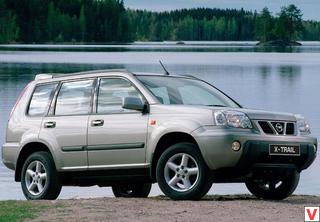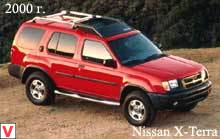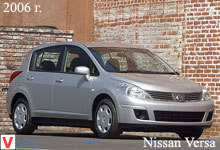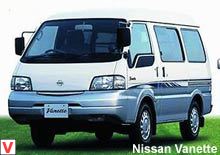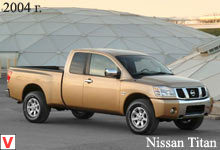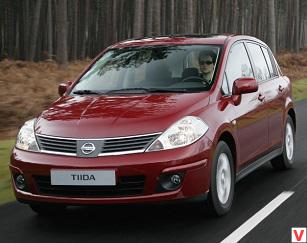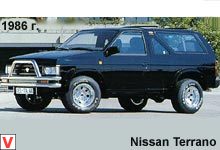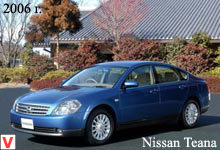
The Pathfinder model is well known by many under the name Terrano. The first generation came out in 1986. This car received the name Pathfinder in the American market, by the way, and it was also produced in the USA. The American version had its own characteristics and differences from the usual Terrano.
For example, the Nissan Pathfinder had a softer suspension, mostly automatic transmission and rear disc brakes. Salon, as a rule, was equipped richer than the Terrano. At first, the Pathfinder was produced in a three-door version, 5-door cars appeared only in 1989. Most often, the Pathfinder had a simple velor interior, although it was possible to find options with expensive leather trim. He was able to accommodate about five people. The main driving force behind the Nissan Pathfinder was a 3-liter V6 engine rated at 147 hp.

The basis of the design was a powerful spar frame, the front suspension of the car, double-lever, torsion, in the spring suspension of the rear wheels a one-piece beam was used. Also in the serial set of the car were necessary for the assault off-road two-stage transfer case and locking rear differential. Production of the Nissan Pathfinder continued until 1996, after which a new second-generation car was shown in the United States and Japan. In 1997 and 1999, the car was upgraded. Nissan Pathfinder, which was born in 1999, caused some criticism from automotive experts. The object of the attack was the engine, which was too weak for this class of cars.
A fundamentally new solution to the transmission of the car, which on the one hand provided its rigidity with ease of control and maneuvering, and on the other hand reduced the noise level of the transmission when the car was moving, remained virtually unnoticed. As expected, the new model has undergone modernization. And already in 2001, under the hood Pathfinder, a new V6 engine with 24 valves made of aluminum, which became more powerful and more economical than its predecessor, appeared. Engine capacity was 3.5 liters, he was able to develop power in the range of 220 - 240 hp Paired with the engine, two variants of gearbox are used: 5-speed manual gearbox and 4-speed automatic.
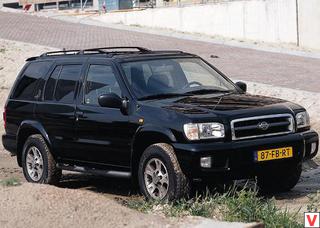
The gas distribution system has become more complicated and has become dynamic control. The engine was also equipped with several complex electronic systems: SOFIS (sophisticated fuel injection optimization system), ECCS (continuous monitoring system), OBDII (on-board diagnostic system), NCVCS (intake valve opening time control system), NDIS (direct ignition system), NVIS (variable intake system), etc. The optics has also changed: they installed parabolic headlights covered with shock-resistant glass.
A variety of electrical devices appeared to make life easier for the driver: heated door locks, sensor for automatic activation of headlights depending on lighting, alarm Vehicle Security System (VSS), controlled with a key fob. Air conditioning with climate control, heated rear passenger seat and of course full power (windows, mirrors, sunroof, seats). The second-generation Nissan Pathfinder is a car that combines permeability and comfort. In 2004, at the Detroit auto show, Nissan introduced a new, already the third generation of the Nissan Pathfinder SUV. This new product is built on a new platform, has a different body design, trim and got a modern V6 engine.

The third generation has become significantly larger, which allowed to place in the cabin three rows of seats, while ensuring high comfort for all passengers. Due to the wide possibilities for the transformation of the cabin, there are 64 different variants of the construction of the cabin! Nissan Pathfinder also boasts an independent suspension for all wheels and a new all-wheel drive system with several modes of operation. Note also that the all-wheel drive system is integrated with other vehicle systems to improve the off-road qualities of the vehicle.
In particular, the novelty received a throttle control system that does not allow its abrupt opening in the event of poor tire adhesion, as well as a system of exchange rate stability, adapted to work in off-road conditions. The third-generation Nissan Pathfinder can be equipped with two powertrain options: a 2.5-liter turbo-diesel with a capacity of 174 hp and a 4-liter gasoline engine with a capacity of 269 hp. Together with a diesel engine can work as a manual gearbox, and automatic, and the petrol version is equipped only with automatic.
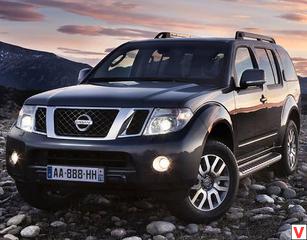
Both engines provide decent dynamics when driving on the highway (acceleration from 0 to 100 km / h is 9 s and 12 s, respectively, for the petrol and diesel versions) and is not too voracious. Safety on the road is provided by disc brakes, an EBD brake force distribution system, and brake assist. Passive safety will provide two frontal airbags. The car received a new supporting frame of steel profiles. Short body overhangs should allow him to better cope with off-road. Separately opening rear door glass - to facilitate baggage loading. The main principles by which the third generation of Pathfinder was created - more capacity and more terrain.
The novelty will be released at one of the company's factories in the USA. In 2010, the company's specialists have restyled the model. Changes in the appearance of the car at least. Only an experienced eye can see the external differences between the old and the modernized Pathfinder. The front bumper has become rounder, and the rear one, on the contrary, is angular. Massive, brilliant grille of three sections, made in the shape of the letter “V” looks a little heavier. The overall impression that arises when looking at the Pathfinder 2010 - a solid, smart and not without aggressiveness SUV.
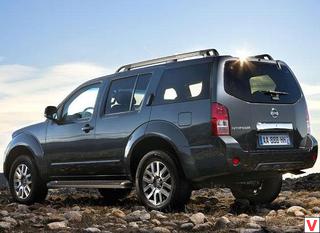
So it makes it sharp, as if carved from stone, body features; prominent prominent arches hanging over wide wheels; powerful roof racks, large glass area, large side steps. The changes also affected the cabin, where it has become much more comfortable. Replaced materials where they could, with more expensive ones by sight and touch, embedded a glowing instrument panel with top versions, for them they also included in the list a new audio-navigation system with a DVD and a hard disk of 40 gigabytes. Inside a lot of space. Neither the driver, nor the front passenger, nor the passengers of the two rear rows will feel cramped.
All passenger seats can be individually folded fully or partially, while fully folded seats form a flat surface without any ledges and transitions. The total number of cabin transformation options is 64. Inside, you can easily transport items up to 2.8 m long. The trunk volume with the rear seats raised is only 190 liters. If you remove them, you get 515 liters. The main change is hidden under the hood.

2.5-liter diesel engine became turbocharged, “matured” by 16 hp and 47 Nm. Now the power is 190 hp at 4000 rpm / minute. The maximum speed of 186 km / h. The motor is aggregated, depending on the configuration, 6-speed manual or 5-speed automatic transmission. Accelerate has become smoother, emit less harmful substances into the atmosphere.
The declared fuel consumption in mixed mode is 9-12 liters per 100 km (from 8-10 liters on the highway, from 11-13.5 liters in the city, depending on the gearbox). The petrol engine is also offered - a 3.0-liter V6 with a capacity of 231 hp. This power unit is offered only in a pair with a 7-speed automatic. In this configuration, the SUV is able to reach a maximum speed of 200 km / h, and the first hundred is gaining in 8.9 seconds. Fuel consumption in the "mixed" mode of movement ~ 10 liters per 100 kilometers. All configurations are equipped with front and rear disc brakes with ABS, independent rear and front suspension, and 17-inch alloy wheels.

This whole set of electronic controls allows the driver to feel confident when driving on sand, driving over rough terrain and deep pools, while overcoming snowdrifts. Geometrical permeability is generally not bad: the exit angle is 26 degrees, the entrance is 33 degrees. Of course, all these changes and improvements were designed to extend the conveyor life of Pathfinder III.
At the 2012 Detroit Auto Show, the Japanese showed the concept of a fourth-generation Nissan Pathfinder, and in early August, the automaker officially introduced the production version of its SUV, which, unlike the previous version, received a supporting body instead of a frame structure. We can safely say that the car was seriously modified both outside and inside. The fourth generation is based on the modular FF-L platform, on which the Infiniti JX and Nissan Murano crossovers are built, as well as the Maxima and Altima sedans. Body dimensions are: 5009 mm in length, 1960 mm in width, 1768 mm in height, 2900 mm wheelbase, 190 mm ground clearance (ground clearance).

Outwardly, the fourth generation began to look more streamlined, having lost rough, chopped forms, but it still largely repeats the silhouette of the predecessor. Particular dynamics of the car body give the rear and front spoilers, as well as suspension skirts and rear tire deflectors. Thanks to their use, the car looks more rapid and aggressive. In addition, these elements of the body structure significantly improve the performance of the aerodynamic resistance of the car. The front part of the car is distinguished by oblique headlamps, an inverted trapezium on the false radiator grille, framed by a wide chrome frame.
For other innovations in the design should include chrome door handles and enlarged taillights. The seven-seater Nissan Pathfinder 2013 salon has got improved finishing materials, including natural leather, and promises enough legroom for the passengers of the second and third rows of seats. As for the interior design, it is fundamentally different from its predecessors. The dashboard is equipped with a 4-inch color monitor on-board computer, as well as an additional touch screen that provides the driver with the main systems of the car.
The refusal of the frame structure, according to the automaker, made it possible to increase the number of options for the transformation of the cabin, as well as to achieve a level floor with the rear seats folded. Thanks to the EZ Flex Seating System's second-row seat transformation system, landing on the third row is comfortable and easy. The second row with separate seats can move along the cabin by 14 cm. The trunk is able to accommodate 453 liters with seven crew members, by folding the third row, we’ll be able to load 1200 liters of cargo, and when transforming the third and second row, a load area of 2260 liters is formed.
The equipment of the Nissan Pathfinder 4 will include a three-zone climate control, a multimedia system with a DVD player and monitors for the rear passengers, a Bose audio system with 13 speakers, an electric tailgate, a circular video review system, a heated steering wheel, and ventilation for the front seats and seat heating second row. Under the hood of the 2013 Nissan Pathfinder is a 3.5-liter petrol engine V6 with a capacity of 265 hp, which is coupled with the latest generation of the CVT Xtronic CVT. There are all-wheel drive and front-wheel drive version. According to the manufacturer, the average fuel consumption of an SUV, compared with its predecessor, has decreased by 25%.
It was possible to achieve such a significant improvement in fuel efficiency due to the abandonment of the frame structure. It also allowed to reduce the weight of the car by 227 kg. The front-wheel-drive SUV weighs 1,882 kg, and all-wheel drive - 1,946 kg. The Pathfinder 2013 has a lighter body and powertrain. It was also possible to reduce the weight of the car due to the installation of a new continuously variable transmission.
Suspension is fully independent, MacPherson strut front, multi-link rear, anti-roll bars are used.
